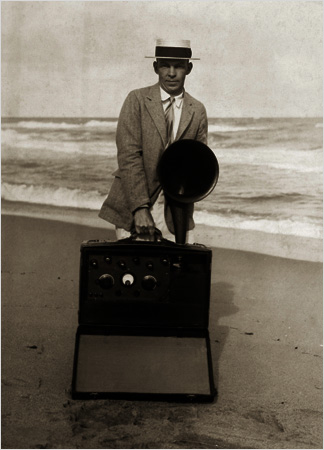| Want to send this page or a link to a friend? Click on mail at the top of this window. |
| More Books and Arts |
| Posted March 30, 2008 |
| IDEAS & TRENDS | |
Behind Every Great Inventor, Many Others Whom History Forgot |
|
 |
|
BETTMAN/CORBIS |
|
| NOT EDISON But Edwin Howard Armstrong came closer than most. He invented FM radio, and much more besides. A patent fight with industry giants, though, led him to suicide. |
By MATT RICHTEL |
SAN FRANCISCO — Invention may be mothered by necessity. But determining the father can require a paternity test.
Take the sound recording. Researchers said last week that they had discovered a recording of a human voice, made by a little-known Frenchman two decades before Thomas Edison’s invention of the phonograph.
An unusual case of innovation misconception? Hardly.
The reality is that the “Aha” moments of industrial creation are preceded by critical moments far less heralded. Behind and beside every big-name inventor are typically lots of others whom history forgot, or never knew. And it’s unusual that an innovation is created in a vacuum (including the vacuum, which itself claims several progenitors).
“It’s rare that you’ve got a major breakthrough that wasn’t developed by multiple people at about the same time,” said Mark Lemley, professor of intellectual property at Stanford Law School.
Or, for that matter, on the same day. Say, for instance, Feb. 14, 1876, when both Alexander Graham Bell and Elisha Gray filed papers with the United States Patent Office to register their competing telephone technologies. Years earlier, the Italian immigrant Antonio Meucci devised his own version of the telephone, but ultimately couldn’t afford the patent application process to defend his innovation.
History remembers Bell, while his rivals are footnotes known mostly by aficionados of intellectual-property trivia.
“It’s not that we wouldn’t have had the telephone. Not only would we have had it, we would have had it the same day,” Mr. Lemley said, adding: “The people who aren’t the winners in the historical dispute sort of fade into obscurity.”
Édouard-Léon Scott de Martinville has certainly been obscure, at least until now. Researchers say that in April 1860, the Parisian tinkerer used a device called a phonautograph to make visual recordings of a woman singing “Au Clair de la Lune.” That was 17 years before Thomas Edison received a patent for the phonograph, and 28 years before his technology was used to capture and play back a piece of a section of a Handel oratorio.
Whom we credit with an invention often has less to do with who came up with an idea, and more to do with who translated it into something usable, accessible, commercial. Garages and laboratories, workbenches and scribbled napkins are filled with brilliant ideas unmatched with determination, resources and market sensibilities, said Jack Russo, a Silicon Valley intellectual-property lawyer.
“People run out of money, they can’t find someone to manufacture for them. There are a gazillion reasons why it doesn’t work out,” Mr. Russo said.
A patent doesn’t hurt, especially the right one. Edison also gets credit for the light bulb, though he got help from the Supreme Court, which in 1895 ruled that his technology did not infringe on a patent the court ruled was too broad, filed by competing (and now forgotten) innovators.
The Wright Brothers held a critical patent for an early airplane, and history rewards them for it. But lots of other innovators were making significant advances in the technology, Mr. Lemley noted.
Some part of the alchemy of anointing inventors has not to do with the innovator at all but with the rest of us — as audience and consumer. Sometimes we’re finally receptive to an idea — whether it is a political meme like civil rights as proffered by the Rev. Dr. Martin Luther King Jr., or an online auction site, like eBay. Great ideas, while perhaps not novel, are delivered to us in palatable packaging just as we’re hungry for them.
Oddly, by the time such a tipping point happens, the innovators of the original spark may find the ideas outdated.
“People come out of the woodwork and get a patent for something fundamental that the others in the field will think is trivial, understood and expected,” said Dennis Allison, a lecturer in electrical engineering at Stanford University.
He has a bit of personal experience both with innovation and watching others get credit for it. In the early and mid-1970s, he was a co-founder of the PCC — People’s Computer Company — which published papers and magazines describing essential early design and technology that begat the computer and then Internet revolution.
“Maybe I have a little bit of a claim — I and the people I was working with — to having invented the personal computer.”
The names we remember are Gates and Jobs, and to a lesser extent Jobs’s early partner, Steve Wozniak. They had an entrepreneurial zeal, marketing genius, a capacity and desire to translate the language of geeks into the products of the common people — just as our lifestyles and work styles and pocketbooks were ready to open up.
Mr. Allison, one among many of the early Silicon Valley innovators whose names seem not destined to be recorded by history, is peaceful with his relatively obscurity.
“I have my contribution,” he said. “The people who I care about know what my role was.”
Copyright 2008 The New York Times Company. Reprinted from The New York Times, Week in Review, of Sunday, March 30, 2008.
| Wehaitians.com, the scholarly journal of democracy and human rights |
| More from wehaitians.com |